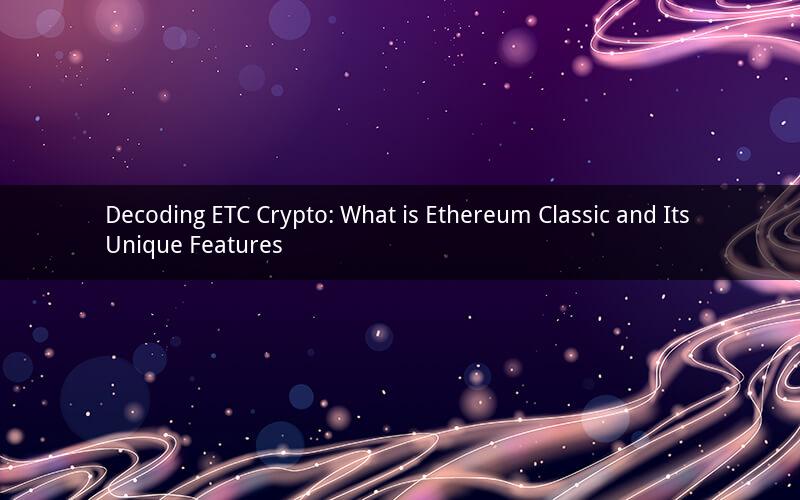
Ethereum Classic (ETC) has emerged as a prominent cryptocurrency, gaining attention from investors and enthusiasts alike. This article delves into the world of ETC crypto, exploring what it is, its history, unique features, and potential future developments.
What is Ethereum Classic?
Ethereum Classic, often abbreviated as ETC, is a decentralized cryptocurrency and blockchain platform that enables the creation of smart contracts and decentralized applications (DApps). It was born out of a contentious hard fork in the Ethereum network in 2016. The fork occurred when the Ethereum community decided to cancel a hack that compromised the network, resulting in the creation of Ethereum (ETH) and Ethereum Classic (ETC).
The core difference between ETC and ETH lies in their approach to resolving the hack. Ethereum chose to move forward with a new blockchain, while Ethereum Classic remained loyal to the original blockchain, which led to the creation of the ETC network.
Unique Features of Ethereum Classic
1. Immutability
One of the most significant features of Ethereum Classic is its immutability. The blockchain is designed to be tamper-proof, ensuring that once data is added to the blockchain, it cannot be altered or deleted. This feature makes ETC a reliable and secure platform for various applications, including financial transactions, voting systems, and supply chain management.
2. Decentralization
Ethereum Classic is a decentralized network, meaning that it operates without a central authority. This decentralized nature makes ETC resistant to censorship and manipulation, as no single entity can control the network. Decentralization also promotes transparency and fairness, as all transactions and smart contracts are visible to all participants.
3. Smart Contracts
Ethereum Classic supports smart contracts, which are self-executing contracts with the terms of the agreement directly written into lines of code. Smart contracts automate various processes, reducing the need for intermediaries and lowering transaction costs. This feature has enabled the development of innovative DApps and has made ETC a viable platform for various applications, including decentralized finance (DeFi) and decentralized exchanges (DEXs).
4. Consensus Mechanism
Ethereum Classic uses the Proof of Work (PoW) consensus mechanism, which is the same mechanism used by Bitcoin. PoW requires miners to solve complex mathematical problems to validate transactions and add new blocks to the blockchain. This process ensures that the network remains secure and decentralized, as it requires significant computational power to compromise the system.
5. Energy Efficiency
Ethereum Classic has been making efforts to improve its energy efficiency. The network has implemented various optimizations, such as the difficulty bomb delay and the ETC Improvement Proposal (EIP) 1459, which aims to reduce the amount of energy consumed by the network.
The Future of Ethereum Classic
The future of Ethereum Classic appears promising, with several factors contributing to its growth:
1. Growing Community
Ethereum Classic has a dedicated and active community that continues to develop the platform and promote its adoption. The community's commitment to the project has helped maintain its relevance in the cryptocurrency space.
2. DApp Development
The increasing number of DApps being developed on the ETC platform suggests that the network is gaining traction as a viable platform for innovative applications. This growth could lead to a surge in user adoption and transaction volume.
3. Partnerships and Collaborations
Ethereum Classic has formed partnerships with various organizations and companies, including exchanges, wallet providers, and blockchain-based projects. These collaborations aim to enhance the platform's capabilities and increase its adoption rate.
4. Energy Efficiency Improvements
As the world becomes more environmentally conscious, the focus on energy efficiency in the cryptocurrency space is growing. Ethereum Classic's efforts to reduce energy consumption may attract more environmentally conscious investors and users.
5. Potential for Market Recovery
The cryptocurrency market has experienced significant volatility over the years. If the market recovers, Ethereum Classic could benefit from increased investor confidence and capital inflows.
In conclusion, Ethereum Classic is a decentralized cryptocurrency and blockchain platform with a unique set of features that make it a compelling investment and development opportunity. Its commitment to immutability, decentralization, and smart contracts, along with its growing community and partnerships, position it for potential future growth.
Questions and Answers:
1. What is the primary difference between Ethereum Classic and Ethereum (ETH)?
Answer: The primary difference between Ethereum Classic (ETC) and Ethereum (ETH) is their approach to resolving the 2016 hack. Ethereum chose to move forward with a new blockchain, while Ethereum Classic remained loyal to the original blockchain.
2. What is a smart contract, and how does it benefit the Ethereum Classic platform?
Answer: A smart contract is a self-executing contract with the terms of the agreement directly written into lines of code. It benefits the Ethereum Classic platform by automating various processes, reducing transaction costs, and promoting transparency.
3. Why is Ethereum Classic considered a secure platform?
Answer: Ethereum Classic is considered a secure platform due to its immutable blockchain, decentralized nature, and the use of the Proof of Work (PoW) consensus mechanism. These features make it resistant to censorship and manipulation.
4. How is Ethereum Classic addressing its energy consumption concerns?
Answer: Ethereum Classic is addressing its energy consumption concerns by implementing various optimizations, such as the difficulty bomb delay and the EIP 1459, which aims to reduce the amount of energy consumed by the network.
5. What are some potential future developments for Ethereum Classic?
Answer: Some potential future developments for Ethereum Classic include continued growth in the community, increased DApp development, partnerships and collaborations, improvements in energy efficiency, and a potential market recovery.